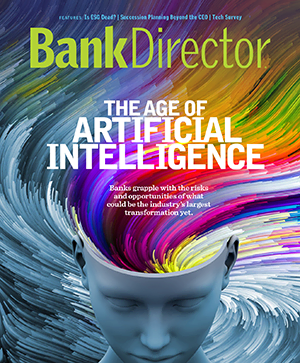
Designing a Pandemic-Proof Compensation Plan
The ability to pivot and adapt to a changing landscape is critical to the success of an organization.
The coronavirus pandemic has created a unique challenge for banks in particular. Government stimulus through the Paycheck Protection Program tasked banks with processing loans at an unheard-of rate, turning bankers working 20-hour days into economic first responders. Simultaneously, the altered landscape forced businesses to adopt a remote work environment, virtual meetings and increase flexibility – amplifying the need for safe and reliable technology platforms, enhanced data security measures and appropriate cyber insurance programs as standard operating procedure.
Prior to Covid-19, a major driver of change was the demographic shift in the workforce as baby boomers retire and Generation X and millennials take over management and leadership positions. Many businesses were focused on ways to attract and retain these workers by adapting their cultures and policies to offer them meaningful rewards. The pandemic will likely make this demographic shift more relevant, as the workforce continues adapting to the impending change.
Gen X and millennial employees are more likely than previous generations to value flexibility in when and where they work. They may seek greater alignment in their career and life, according to Gallup. The pandemic has forced businesses to either adapt – or risk the economic consequences of losing their top performers to competitors.
Many employees find they are more productive when working remotely compared to the traditional office setting, which could translate into increased employee engagement. In fact, the Gallup’s “State of the American Workplace” study finds that employees who spend 60% to 80% of their time working remotely reported the highest engagement. Engagement relates to the level of involvement and the relationship an employee has with their position and employer. Gallup finds that engaged employees are more productive because they have increased autonomy, job satisfaction and desire to make a difference. Simply put, increase engagement and performance will rise.
The demographic shift and a force-placed virtual office culture means that designing programs to attract and retain today’s workers require a well thought out combination of strategies. An inexpensive – though not necessarily simple – method of employee retention includes providing recognition when appropriate and deserved. Recognition is a critical aspect in employee engagement, regardless of demographic. Employees who feel recognized are more likely to be retained, satisfied and highly engaged. Without appropriate recognition, employee turnover could increase, which contributes to decreased morale and reduced productivity.
In addition to showing appreciation and recognizing employees who perform well, compensating them appropriately is fundamental to attracting and retaining the best. The flexibility of a non-qualified deferred compensation program allows employers to customize the design to respond to changing needs.
Though still relevant, the traditional Supplemental Executive Retirement Plan has been used to attract and retain leadership positions. It is an unsecured promise to pay a future benefit in retirement, with a vesting schedule structured to promote retention. Because Gen X and millennials may have 25 years or more until retirement, the value of a benefit starting at age 65 or later could miss the mark; they may find a more near-term, personally focused, approach to be more meaningful.
Taking into consideration what a younger employee in a leadership, management, or production position values is the guide to developing an effective plan. Does the employee have young children, student loan debt or other current expenses? Using personalized criteria, the employer can structure a deferred compensation program to customize payments timed to coincide with tuition or student loan debt repayment assistance. Importantly, the employer is in control of how these programs vest, can include forfeiture provision features and require the employee perform to earn the benefits.
These benefits are designed to be mutually beneficial. The rewards must be meaningful to the recipient while providing value to the sponsoring employer. The employer attracts and retains top talent while increasing productivity, and the employee is engaged and compensated appropriately. Banks can increase their potential success and avoid the financial consequences of turnover.
Ultimately, the pandemic could be the catalyst that brings the workplace of tomorrow to the present day. Nimbleness as we face the new reality of a virtual office, flexibility, and reliance on technology will holistically increase our ability to navigate uncertainty.


